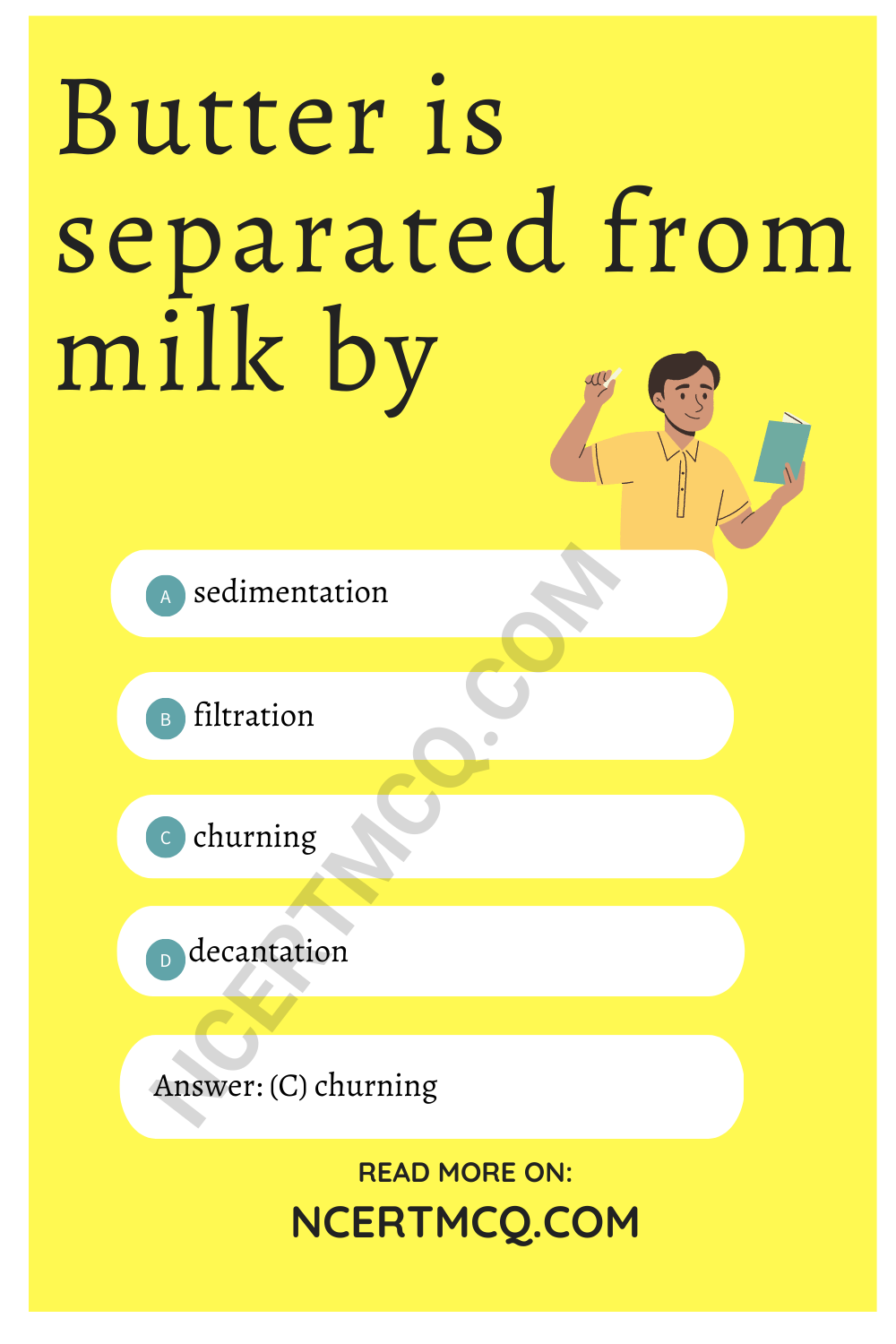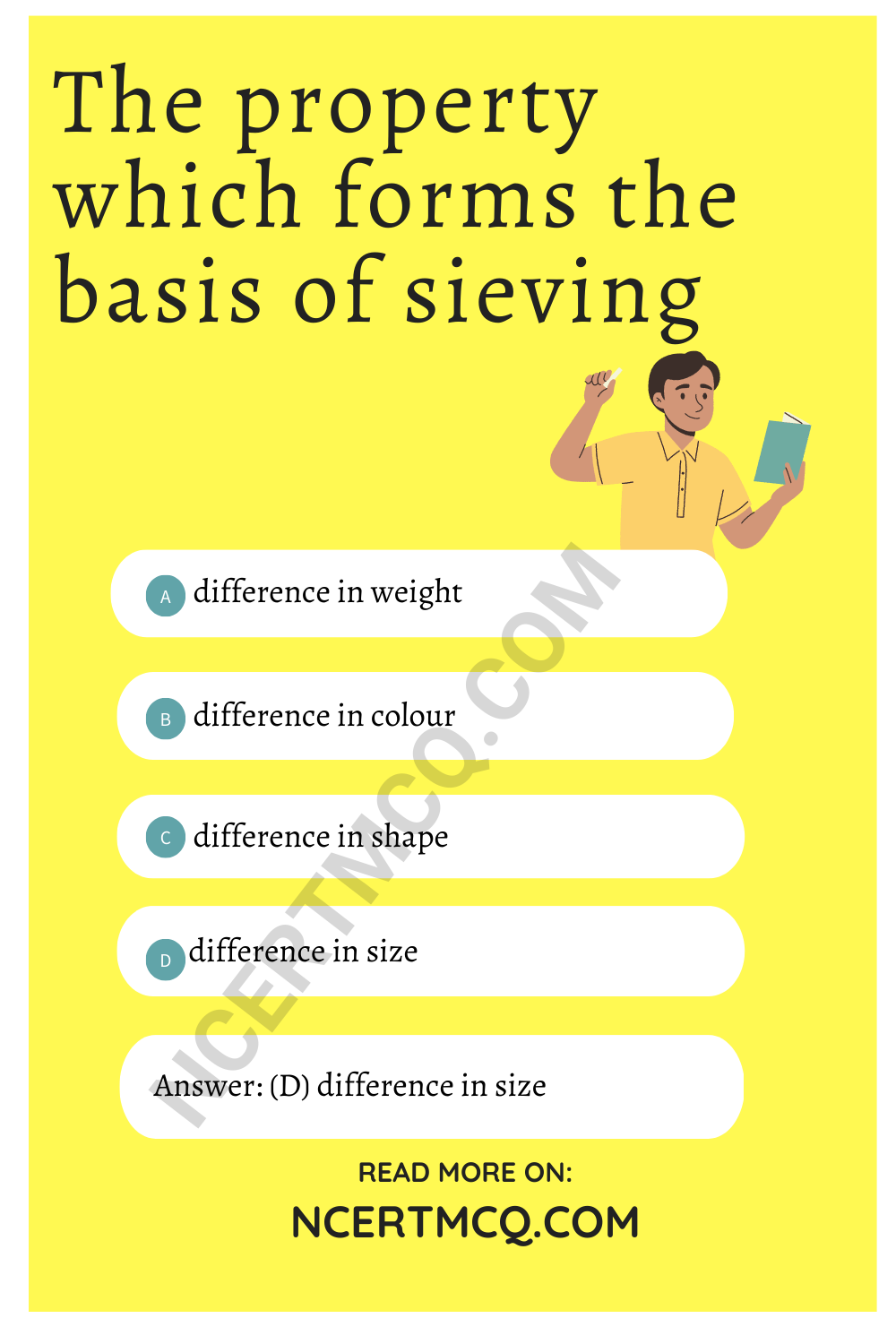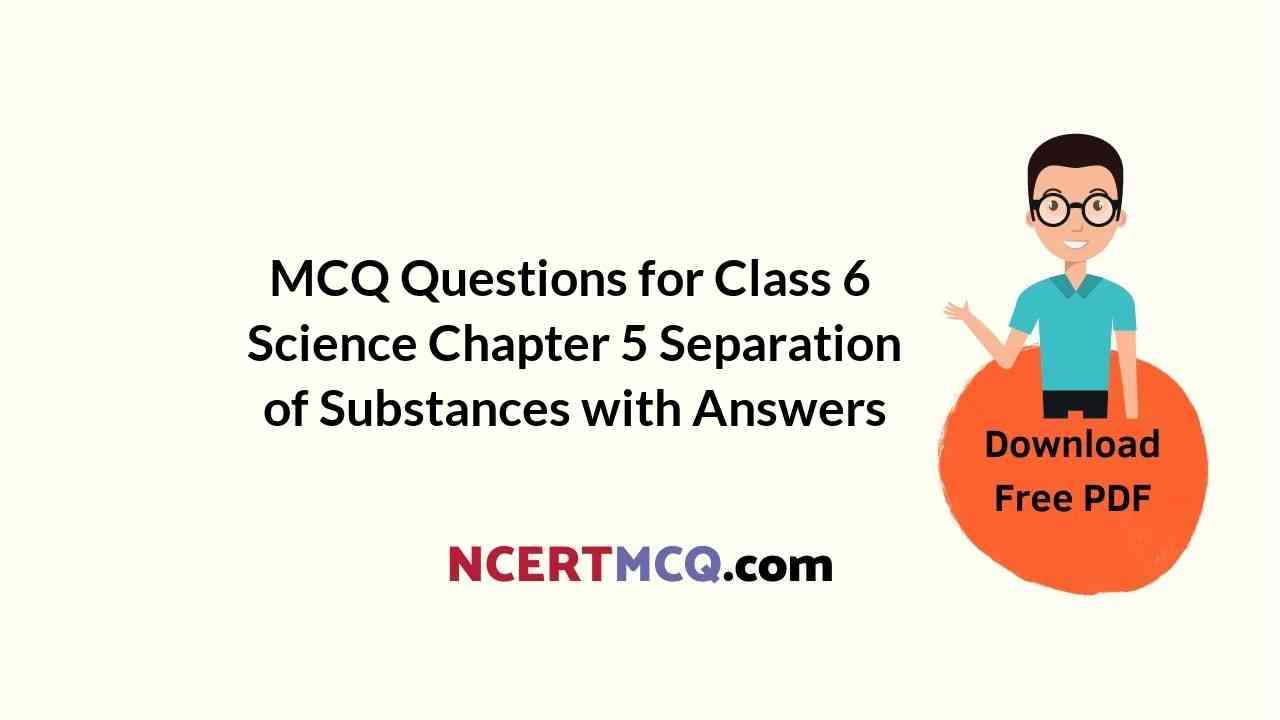Check the below Online Education NCERT MCQ Questions for Class 6 Science Chapter 5 Separation of Substances with Answers Pdf free download. MCQ Questions for Class 6 Science with Answers were prepared based on the latest exam pattern. We have provided Separation of Substances Class 6 Science MCQs Questions with Answers to help students understand the concept very well.
You can refer to NCERT Solutions for Class 6 Science Chapter 5 Separation of Substances to revise the concepts in the syllabus effectively and improve your chances of securing high marks in your board exams.
Class 6 Science Chapter 5 MCQ With Answers
Science Class 6 Chapter 5 MCQs On Separation of Substances
Choose the correct option in the following questions:
Separation Of Substances Class 6 MCQ Question 1.
Butter is separated from milk by
(a) sedimentation
(b) filtration
(c) churning
(d) decantation
Answer
Answer: (c) churning
Explanation:
Butter is separated by churning.

Class 6 Science Chapter 5 MCQ Question 2.
Filtration is a method to separate the components of a
(a) solution
(b) mixture of a liquid and an insoluble substance
(c) both (a) and (b)
(d) pure substance
Answer
Answer: (b) mixture of a liquid and an insoluble substance
Explanation:
Components of solution cannot be separated by this method.
MCQ Questions For Class 6 Science Chapter 5 Question 3.
Threshing is done by
(a) beating
(b) bullocks
(c) machines
(d) all of these
Answer
Answer: (d) all of these
Explanation:
All the three methods can be used for threshing.
MCQ On Separation Of Substances Class 6 Question 4.
Which method is used to separate pebbles and stones from sand?
(a) Handpicking
(b) Winnowing
(c) Sieving
(d) Any of these
Answer
Answer: (c) Sieving
Explanation:
Handpicking will require more time while winnowing is not fit at all.
Separation Of Substances MCQ Question 5.
The components of a solution (say sugar in water) can be separated by
(a) filtration
(b) evaporation
(c) sedimentation
(d) decantation
Answer
Answer: (b) evaporation
Explanation:
By evaporation, the volatile component is evaporated which is then condensed.
Separation Of Substances Class 6 MCQ With Answers Question 6.
Sand from water is separated by
(a) sieving
(b) evaporation
(c) filtration
(d) sedimentation and decantation
Answer
Answer: (d) sedimentation and decantation
Explanation:
It can be done by evaporation and filtration also but sedimentation and decantation are easier ways.
Separation Of Substances Class 6 Worksheets With Answers MCQ Question 7.
The process of conversion of water vapours into liquid is called
(a) condensation
(b) decantation
(c) sedimentation
(d) evaporation
Answer
Answer: (a) condensation
Explanation:
Water vapours changing into liquid is called condensation.
Ncert Class 6 Science Chapter 5 MCQ Question 8.
The process of conversion of water into its vapours is called
(a) evaporation
(b) condensation
(c) guttation
(d) transpiration
Answer
Answer: (a) evaporation
Explanation:
The conversion of water into vapours is called evaporation.
Class 6 Science Chapter 5 MCQ With Answers Question 9.
A mixture of ammonium chloride and sand is separated by
(a) evaporation
(b) decantation
(c) sublimation
(d) filtration
Answer
Answer: (c) sublimation
Explanation:
Ammonium chloride is separated by sublimation process.
Class 6 Separation Of Substances MCQ Question 10.
The property which forms the basis of sieving
(a) difference in weight
(b) difference in colour
(c) difference in shape
(d) difference in size
Answer
Answer: (d) difference in size
Explanation:
Sieving method is used for separating solid constituents of a mixture which differ in their size.

Match the following items given in Column A with that in Column B:
| Column A | Column B |
| (a) Handpicking | (i) Conversion of water vapours into liquids |
| (b) Threshing | (ii) Separating bran from flour |
| (c) Winnowing | (iii) Separating larger size impurities |
| (d) Sieving | (iv) Separating butter from milk |
| (e) Sedimentation | (v) Conversion of water into Us vapours |
| (f) Evaporation | (vi) Separating grains from its stalks |
| (g) Condensation | (vii) Settling of heavier components at bottom |
| (h) Churning | (viii) Separation by wind or by blowing air |
Answer
Answer:
| Column A | Column B |
| (a) Handpicking | (iii) Separating larger size impurities |
| (b) Threshing | (iv) Separating grains from its stalks |
| (c) Winnowing | (viii) Separation by wind or by blowing air |
| (d) Sieving | (ii) Separating bran from flour |
| (e) Sedimentation | (vii) Settling of heavier components at bottom |
| (f) Evaporation | (v) Conversion of water into its vapours |
| (g) Condensation | (i) Conversion of water vapours into liquids |
| (h) Churning | (iv) Separating butter from milk |
Fill in the blanks with appropriate words:
1. Peanuts are separated from a mixture of wheat and peanut by …………… .
Answer
Answer: handpicking
2. ………………. is used to separate husk from wheat.
Answer
Answer: Winnowing
3. Fine sand can be separated from larger particles by ……………. .
Answer
Answer: sieving
4. Glass is a ………….. .
Answer
Answer: mixture
5. Compounds have ……………….. melting points.
Answer
Answer: fixed
6. Milk has a ……………………….. boiling point.
Answer
Answer: variable
7. Boiling point of pure water is …………………. than that of impure water.
Answer
Answer: less
8. Mixture may be solid, liquid or …………… .
Answer
Answer: gas
9. Butter is a component of …………….. .
Answer
Answer: butter milk
10. Sugarcane juice is a mixture of …………………………, water and many other substances.
Answer
Answer: sugar
11. Separation of components is done to obtain a …………………….. substance.
Answer
Answer: pure
12. Components retain their properties in a ……………… .
Answer
Answer: mixture
State whether the statements given below are True or False:
1. Butter is separated from butter milk by churning.
Answer
Answer: True
2. Separation of components of a mixture is a useful process.
Answer
Answer: True
3. Ink loses its properties when mixed in water.
Answer
Answer: False
4. ‘Sharbat’ is a mixture of sugar and water.
Answer
Answer: True
5. Rocks are pure substances.
Answer
Answer: False
6. Milk is a mixture.
Answer
Answer: True
7. Common salt is ai pure substance.
Answer
Answer: True
8. Mixture has properties different from its components.
Answer
Answer: False
9. Tap water and pond water are alike.
Answer
Answer: False
10. Elements are pure substances.
Answer
Answer: True
11. A pure substance has a fixed melting and boiling points.
Answer
Answer: True
12. Condensation method is used for separating substances which on heating change directly into vapour.
Answer
Answer: False
We hope the given NCERT MCQ Questions for Class 6 Science Chapter 5 Separation of Substances with Answers Pdf free download will help you. If you have any queries regarding Separation of Substances CBSE Class 6 Science MCQs Multiple Choice Questions with Answers, drop a comment below and we will get back to you soon.
Class 6 Science MCQ:
- Food Where Does It Come From Class 6 MCQ
- Components of Food Class 6 MCQ
- Fibre to Fabric Class 6 MCQ
- Sorting Materials Into Groups Class 6 MCQ
- Separation of Substances Class 6 MCQ
- Changes Around Us Class 6 MCQ
- Getting to Know Plants Class 6 MCQ
- Body Movements Class 6 MCQ
- The Living Organisms and Their Surroundings Class 6 MCQ
- Motion and Measurement of Distances Class 6 MCQ
- Light Shadows and Reflection Class 6 MCQ
- Electricity and Circuits Class 6 MCQ
- Fun with Magnets Class 6 MCQ
- Water Class 6 MCQ
- Air Around Us Class 6 MCQ
- Garbage In Garbage Out Class 6 MCQ
